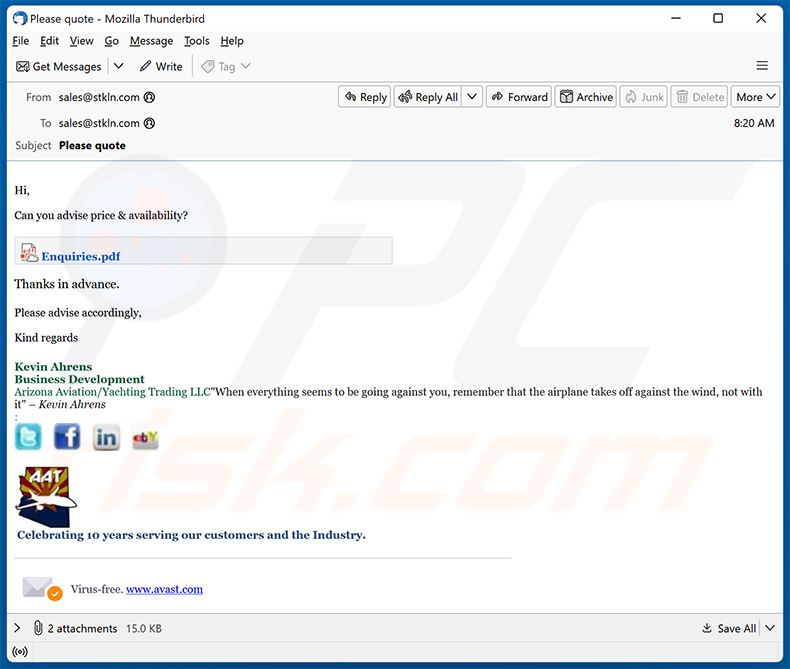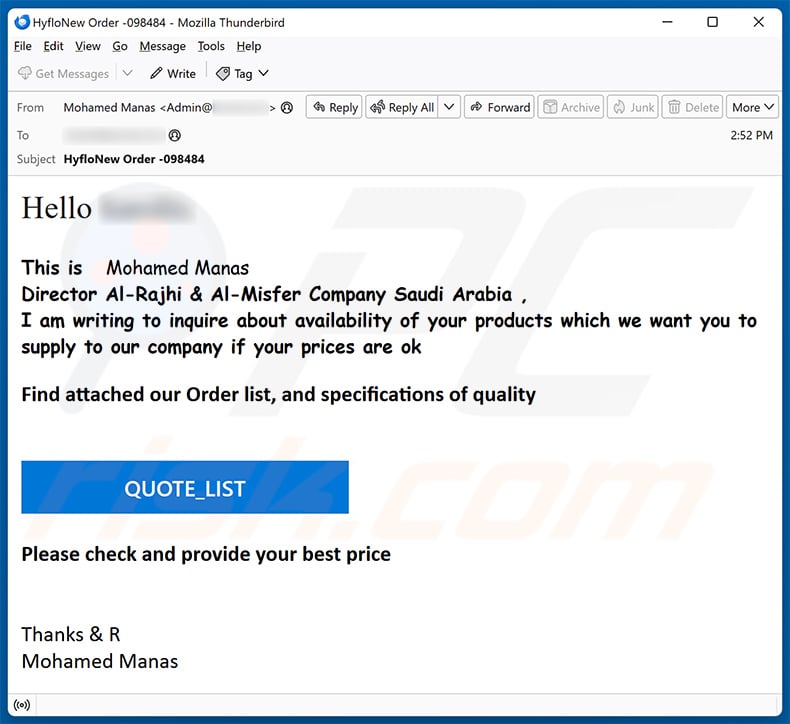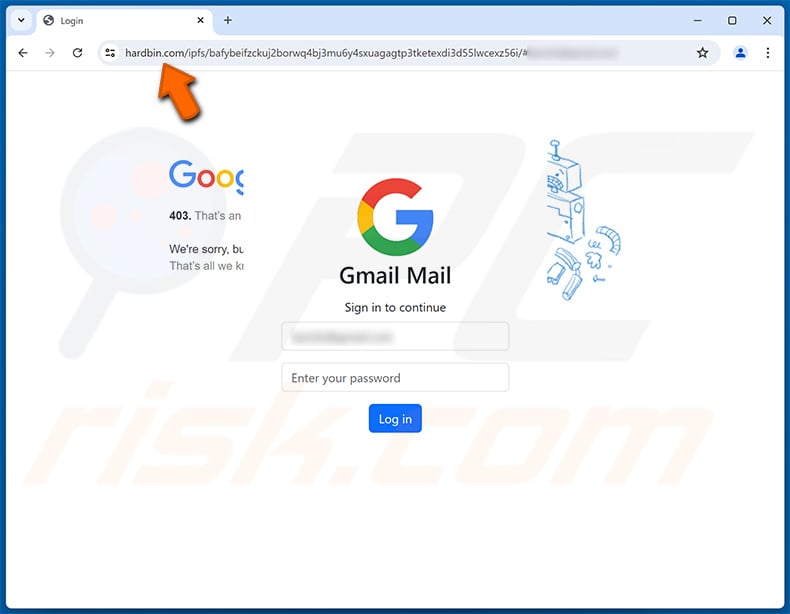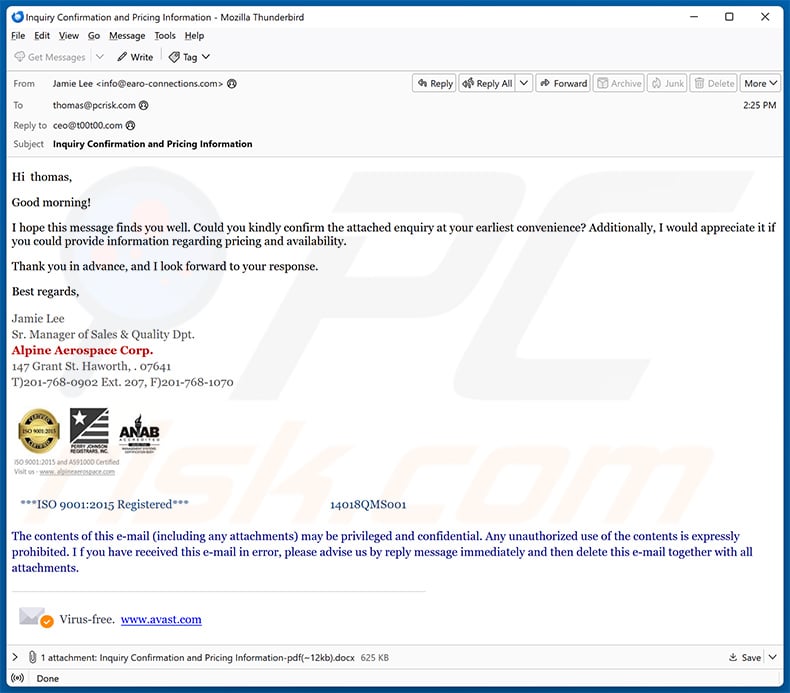Avoid losing your account via fake "Price And Stock Availability" emails
Phishing/ScamAlso Known As: "Price And Stock Availability" phishing email
Get free scan and check if your device is infected.
Remove it nowTo use full-featured product, you have to purchase a license for Combo Cleaner. Seven days free trial available. Combo Cleaner is owned and operated by RCS LT, the parent company of PCRisk.com.
What kind of email is "Price And Stock Availability"?
After analyzing the "Price And Stock Availability" email, we determined that it is spam. This letter is presented as a purchase inquiry. The attachment containing the details is actually a phishing file that targets email account log-in credentials (passwords).

"Price And Stock Availability" email scam overview
The spam email with the subject "New Order-241" (may vary) allegedly includes a purchase inquiry attached to it. The recipient is requested to review the attachment and provide the stock availability, best price, shipping cost, and approximate weight.
It must be emphasized that all this information is false, and this email is in no way associated with any legitimate companies or other entities.
The attachment – "SHKX202311019.rar_xls.shtml" (filename may vary) – is an HTML document that operates as a phishing file. Upon opening, it appears as a blurred Excel spreadsheet; the pop-up atop it asks to enter the email password to download/view this file. Phishing files record provided information and send it to cyber criminals.
Emails are of particular interest to scammers; these accounts are typically used to register other content, which may then get stolen as well. To elaborate on the potential misuse, cyber criminals can steal the identities of social account owners (e.g., emails, social media, social networking, etc.) and ask the contacts/friends/followers for donations or loans, endorse scams, and spread malware by sharing malicious files/links.
Hijacked finance-related accounts (e.g., online banking, money transferring, e-commerce, cryptocurrency wallets, etc.) can be used to make fraudulent transactions and/or online purchases.
To summarize, victims of scam mail like "Price And Stock Availability" can experience severe privacy issues, financial losses, and even identity theft.
If you have already disclosed your account credentials – immediately change the passwords of all possibly exposed accounts and inform their official support.
| Name | "Price And Stock Availability" phishing email |
| Threat Type | Phishing, Scam, Social Engineering, Fraud |
| Fake Claim | Email includes a purchase inquiry in an attachment. |
| Attachment(s) | SHKX202311019.rar_xls.shtml (filename may vary) |
| Detection Names | Avast (HTML:Phishing-CSO [Phish]), Combo Cleaner (Generic.JS.FakeLogin.A.FFF9A032), ESET-NOD32 (HTML/Phishing.Agent.ESF), Fortinet (HTML/FakeLogin.295297D2!phish), Microsoft (Trojan:Script/Phonzy.B!ml), Full List Of Detections (VirusTotal) |
| Symptoms | Unauthorized online purchases, changed online account passwords, identity theft, illegal access of the computer. |
| Distribution methods | Deceptive emails, rogue online pop-up ads, search engine poisoning techniques, misspelled domains. |
| Damage | Loss of sensitive private information, monetary loss, identity theft. |
| Malware Removal (Windows) |
To eliminate possible malware infections, scan your computer with legitimate antivirus software. Our security researchers recommend using Combo Cleaner. Download Combo CleanerTo use full-featured product, you have to purchase a license for Combo Cleaner. 7 days free trial available. Combo Cleaner is owned and operated by RCS LT, the parent company of PCRisk.com. |
Phishing spam campaign examples
"Protected Message", "Confirm If The Prices Are Still Valid", "DHL Global Express Shipping", "Publishers Clearing House", and "Payment Order" are merely some examples of phishing emails we have investigated recently.
These letters primarily target various log-in credentials, personally identifiable details, and finance-related information. However, other scams are promoted through spam mail as well. It is also used to distribute malware.
Due to how prevalent spam mail is and how well-made it can be – we strongly advise exercising caution with incoming emails, DMs/PMs, SMSes, and other messages.
How do spam campaigns infect computers?
Spam campaigns are commonly utilized in malware distribution. Deceptive emails/messages can include malicious files as attachments or download links. These files can be archives (ZIP, RAR, etc.), executables (.exe, .run, etc.), documents (PDF, Microsoft Office, Microsoft OneNote, etc.), JavaScript, and so on.
When a virulent file is opened – it initiates the malware download/installation process. However, some formats may require additional actions to jumpstart these processes. For example, Microsoft OneNote documents need users to click on embedded files/links, while Microsoft Office files require them to enable macro commands (i.e., editing/content).
How to avoid installation of malware?
It is important to always treat incoming emails and other messages with care. Attachments or links found in suspicious/irrelevant mail must not be opened, as they can be malicious. We recommend using post-2010 Microsoft Office versions since they have the "Protected View" mode that prevents automatic macro execution.
It must be mentioned that malware is spread using various techniques. Therefore, we also advise caution when browsing, as fraudulent and dangerous online content usually appears legitimate and innocuous.
Furthermore, all downloads must be performed from official and verified channels. Another recommendation is to activate and update software by using genuine functions/tools, as illegal activation ("cracking") tools and third-party updates may contain malware.
We must stress the importance of having a reputable anti-virus installed and kept updated. Security programs must be used to run regular system scans and to remove threats and issues. If you've already opened malicious attachments, we recommend running a scan with Combo Cleaner Antivirus for Windows to automatically eliminate infiltrated malware.
Text presented in the "Price And Stock Availability" spam email letter:
Subject: New Order-241
Hello Dear,
You are kindly asked to inform the best price and stock availability for
the following as attached.
Also, please provide along with shipping cost and approximate weight.
Look forward to your kind offer
Regards
C.Kara/Ms.
BERTH TEAM
www. berthparts.com [1]
info@berthparts.com
_Phone : +90 224 251 25 23 (pbx)_
_Mobile : +90 533 206 18 11_
_Fax : +90 224 251 25 45_
_Kibris Sehitleri Cad., No:50/206, _
_16220, Bursa / TURKEY_
Screenshot of the phishing file attached to this spam email ("SHKX202311019.rar_xls.shtml"):

Other examples of Price And Stock Availability-themed spam emails:
Sample 1 (link leads to a malicious executable)

Sample 2:

Text presented within:
Subject: HyfloNew Order -098484
Hello ********,
This is Mohamed Manas
Director Al-Rajhi & Al-Misfer Company Saudi Arabia ,I am writing to inquire about availability of your products which we want you to supply to our company if your prices are ok
Find attached our Order list, and specifications of quality
QUOTE_LIST
Please check and provide your best price
Thanks & R
Mohamed ManasAl-Rajhi & Al-Misfer Company
PO Box 58684 Riyadh 11515 Saudi Arabia
Screenshot of the promoted phishing site:

Sample 3 (attachment - malicious MS Word document):

Text presented within:
Subject: Inquiry Confirmation and Pricing Information
Hi -,
Good morning!
I hope this message finds you well. Could you kindly confirm the attached enquiry at your earliest convenience? Additionally, I would appreciate it if you could provide information regarding pricing and availability.
Thank you in advance, and I look forward to your response.
Best regards,
Jamie LeeSr. Manager of Sales & Quality Dpt.
Alpine Aerospace Corp.
147 Grant St. Haworth, . 07641
T)201-768-0902 Ext. 207, F)201-768-1070
Instant automatic malware removal:
Manual threat removal might be a lengthy and complicated process that requires advanced IT skills. Combo Cleaner is a professional automatic malware removal tool that is recommended to get rid of malware. Download it by clicking the button below:
DOWNLOAD Combo CleanerBy downloading any software listed on this website you agree to our Privacy Policy and Terms of Use. To use full-featured product, you have to purchase a license for Combo Cleaner. 7 days free trial available. Combo Cleaner is owned and operated by RCS LT, the parent company of PCRisk.com.
Quick menu:
- What is "Price And Stock Availability" phishing email?
- Types of malicious emails.
- How to spot a malicious email?
- What to do if you fell for an email scam?
Types of malicious emails:
![]() Phishing Emails
Phishing Emails
Most commonly, cybercriminals use deceptive emails to trick Internet users into giving away their sensitive private information, for example, login information for various online services, email accounts, or online banking information.
Such attacks are called phishing. In a phishing attack, cybercriminals usually send an email message with some popular service logo (for example, Microsoft, DHL, Amazon, Netflix), create urgency (wrong shipping address, expired password, etc.), and place a link which they hope their potential victims will click on.
After clicking the link presented in such email message, victims are redirected to a fake website that looks identical or extremely similar to the original one. Victims are then asked to enter their password, credit card details, or some other information that gets stolen by cybercriminals.
![]() Emails with Malicious Attachments
Emails with Malicious Attachments
Another popular attack vector is email spam with malicious attachments that infect users' computers with malware. Malicious attachments usually carry trojans that are capable of stealing passwords, banking information, and other sensitive information.
In such attacks, cybercriminals' main goal is to trick their potential victims into opening an infected email attachment. To achieve this goal, email messages usually talk about recently received invoices, faxes, or voice messages.
If a potential victim falls for the lure and opens the attachment, their computers get infected, and cybercriminals can collect a lot of sensitive information.
While it's a more complicated method to steal personal information (spam filters and antivirus programs usually detect such attempts), if successful, cybercriminals can get a much wider array of data and can collect information for a long period of time.
![]() Sextortion Emails
Sextortion Emails
This is a type of phishing. In this case, users receive an email claiming that a cybercriminal could access the webcam of the potential victim and has a video recording of one's masturbation.
To get rid of the video, victims are asked to pay a ransom (usually using Bitcoin or another cryptocurrency). Nevertheless, all of these claims are false - users who receive such emails should ignore and delete them.
How to spot a malicious email?
While cyber criminals try to make their lure emails look trustworthy, here are some things that you should look for when trying to spot a phishing email:
- Check the sender's ("from") email address: Hover your mouse over the "from" address and check if it's legitimate. For example, if you received an email from Microsoft, be sure to check if the email address is @microsoft.com and not something suspicious like @m1crosoft.com, @microsfot.com, @account-security-noreply.com, etc.
- Check for generic greetings: If the greeting in the email is "Dear user", "Dear @youremail.com", "Dear valued customer", this should raise suspiciousness. Most commonly, companies call you by your name. Lack of this information could signal a phishing attempt.
- Check the links in the email: Hover your mouse over the link presented in the email, if the link that appears seems suspicious, don't click it. For example, if you received an email from Microsoft and the link in the email shows that it will go to firebasestorage.googleapis.com/v0... you shouldn't trust it. It's best not to click any links in the emails but to visit the company website that sent you the email in the first place.
- Don't blindly trust email attachments: Most commonly, legitimate companies will ask you to log in to their website and to view any documents there; if you received an email with an attachment, it's a good idea to scan it with an antivirus application. Infected email attachments are a common attack vector used by cybercriminals.
To minimise the risk of opening phishing and malicious emails we recommend using Combo Cleaner Antivirus for Windows.
Example of a spam email:

What to do if you fell for an email scam?
- If you clicked on a link in a phishing email and entered your password - be sure to change your password as soon as possible. Usually, cybercriminals collect stolen credentials and then sell them to other groups that use them for malicious purposes. If you change your password in a timely manner, there's a chance that criminals won't have enough time to do any damage.
- If you entered your credit card information - contact your bank as soon as possible and explain the situation. There's a good chance that you will need to cancel your compromised credit card and get a new one.
- If you see any signs of identity theft - you should immediately contact the Federal Trade Commission. This institution will collect information about your situation and create a personal recovery plan.
- If you opened a malicious attachment - your computer is probably infected, you should scan it with a reputable antivirus application. For this purpose, we recommend using Combo Cleaner Antivirus for Windows.
- Help other Internet users - report phishing emails to Anti-Phishing Working Group, FBI’s Internet Crime Complaint Center, National Fraud Information Center and U.S. Department of Justice.
Frequently Asked Questions (FAQ)
Why did I receive this email?
Spam emails are not personal. This mail is sent out in massive campaigns – hence, thousands of users receive identical letters.
I have provided my personal information when tricked by this spam email, what should I do?
If you have provided your log-in credentials – change the passwords of all possibly compromised accounts and inform their official support without delay. And if the disclosed information was of a different personal nature (e.g., ID card details, passport photos/scans, credit card numbers, etc.) – immediately contact relevant authorities.
I have read a spam email but didn't open the attachment, is my computer infected?
Systems are infected when malicious attachments or links are opened – merely reading an email is harmless.
I have downloaded and opened a file attached to a spam email, is my computer infected?
Whether an infection occurred depends on the purpose of the attachment (i.e., phishing vs. malware download/installation). The format of a malicious file can impact this as well.
Executables (.exe, .run, etc.) cause infections almost without fail upon being opened. Meanwhile, documents (.doc, .xls, .pdf, .one, etc.) might need extra actions to jumpstart system infection processes. For example, enabling macro commands, clicking embedded content, etc.
Will Combo Cleaner remove malware infections present in email attachments?
Yes, Combo Cleaner can scan systems and eliminate all manner of threats. It can remove practically all known malware infections. Note that since sophisticated malicious software tends to hide deep within systems – performing a full system scan is paramount.
Share:

Tomas Meskauskas
Expert security researcher, professional malware analyst
I am passionate about computer security and technology. I have an experience of over 10 years working in various companies related to computer technical issue solving and Internet security. I have been working as an author and editor for pcrisk.com since 2010. Follow me on Twitter and LinkedIn to stay informed about the latest online security threats.
PCrisk security portal is brought by a company RCS LT.
Joined forces of security researchers help educate computer users about the latest online security threats. More information about the company RCS LT.
Our malware removal guides are free. However, if you want to support us you can send us a donation.
DonatePCrisk security portal is brought by a company RCS LT.
Joined forces of security researchers help educate computer users about the latest online security threats. More information about the company RCS LT.
Our malware removal guides are free. However, if you want to support us you can send us a donation.
Donate
▼ Show Discussion